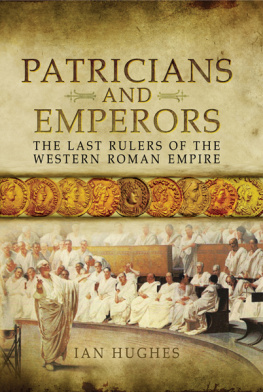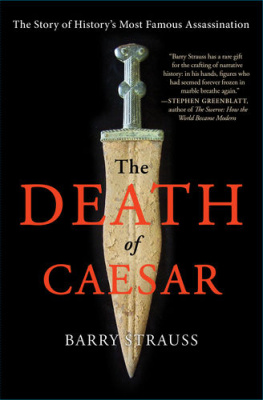A Military Life of Constantine the Great
A Military Life of Constantine the Great
Ian Hughes
First published in Great Britain in 2020 by
Pen & Sword Military
An imprint of
Pen & Sword Books Ltd
Yorkshire Philadelphia
Copyright Ian Hughes 2020
ISBN 978 1 52672 423 6
eISBN 978 1 52672 424 3
Mobi ISBN 978 1 52672 425 0
The right of Ian Hughes to be identified as Author of this work has been asserted by him in accordance with the Copyright, Designs and Patents Act 1988.
A CIP catalogue record for this book is available from the British Library.
All rights reserved. No part of this book may be reproduced or transmitted in any form or by any means, electronic or mechanical including photocopying, recording or by any information storage and retrieval system, without permission from the Publisher in writing.
Pen & Sword Books Limited incorporates the imprints of Atlas, Archaeology, Aviation, Discovery, Family History, Fiction, History, Maritime, Military, Military Classics, Politics, Select, Transport, True Crime, Air World, Frontline Publishing, Leo Cooper, Remember When, Seaforth Publishing, The Praetorian Press, Wharncliffe Local History, Wharncliffe Transport, Wharncliffe True Crime and White Owl.
For a complete list of Pen & Sword titles please contact
PEN & SWORD BOOKS LIMITED
47 Church Street, Barnsley, South Yorkshire, S70 2AS, England
E-mail:
Website: www.pen-and-sword.co.uk
Or
PEN AND SWORD BOOKS
1950 Lawrence Rd, Havertown, PA 19083, USA
E-mail:
Website: www.penandswordbooks.com
Contents
Introduction
Abbreviations
Chapter 1 Background
Chapter 2 Diocletian and His Reforms
Chapter 3 Constantius and Son
Chapter 4 The Rise of Constantine
Chapter 5 The Conquest of Northern Italy
Chapter 6 The Battle of the Milvian Bridge
Chapter 7 Constantine: Western Emperor
Chapter 8 The Bellum Cibalense
Chapter 9 Descent to War
Chapter 10 The Final Conflict
Chapter 11 The Reforms
Chapter 12 Crispus and Fausta
Chapter 13 Sole Emperor
Chapter 14 Constantines Later Campaigns
Chapter 15 Aftermath and Conclusion
Constantines Campaigns (Born c.272)
Notes
Select Bibliography
Introduction
G iven that there are many, many books, articles and websites covering many aspects of the life and times of Constantine I The Great, the First Christian Emperor of the Roman Empire, it is probably necessary to justify the production of yet another to add to the extensive list.
Without doubt, the majority of the works about Constantine concern his conversion to Christianity and the impact this had, both on the Roman Empire and on the growing Christian religion. Specific aspects for extensive analysis include dissertations on his vision prior to the Battle of the Milvian Bridge, the First Council of Arles in 314, his persecution of the Donatists in Africa and the First Council of Nicaea in ad 325. However, the greatest number cover the question of how , when or even, in a minority of cases, if Constantine actually converted to Christianity.
Of the remainder, the main thrust of the text is usually the timing and nature of the change from the earlier Principate , where the Roman Emperor was seen as the Princeps (First or Leading Man) and was theoretically seen as the First Among Equals, to the Dominate , where the Emperor was given the title Dominus (Lord) and was undoubtedly seen as being above normal men. This change is usually attributed to the reign of Diocletian, with Constantine being the main beneficiary since he then conquered the whole Empire in the early fourth century.
All of these approaches assess individual aspects of Constantines life, generally without placing that life within its context. For, more than anything, Constantine was a man of his time and of his culture. The late-third and early-fourth centuries were a period of turmoil and change within the Empire. Unlike the early years of the Empire, emperors were no longer necessarily members of the political and educated elite. Instead, they were often lower-class men promoted due to their military ability following a pathway through to membership of the higher echelons of the army.
Likewise, with relation to religion, the early Empire had an inclusive policy towards religion, with foreign gods being identified as aspects of Graeco-Roman deities, and so their veneration was an accepted part of Roman culture, with the odd exclusion due to some forms of worship being thought unacceptable; for example, some of the more exotic rites of the East. However, the third century had seen the rise of new forms of religion, with Mithraism and Christianity, forms of monotheism, growing. It should be remembered, though, that at this time Christianity was simply a label covering several disparate sects and communities who each believed slightly different variations of the religious texts which later became known, after much revision and editing, as The Bible. Possibly in response, but certainly concurrently, the old Graeco-Roman religion had been undergoing changes, with a growth in the concept that the Roman gods were all aspects of one single deity, commonly worshipped as Sol Invictus (Unconquered Sun).
Consequently, the early life and attested conversion of Constantine must be placed within the context of his being elevated to the throne as a military commander, which remained one of the central pillars of his career, amid the religious turmoil and confusion caused by the rise of Christianity in its many forms. By studying Constantine solely within the framework of his religious policies and beliefs, it is possible that a significant aspect of his rise and rule is often overlooked.
The aim of this book is to assess Constantines rise and reign from a military viewpoint, and as such it will remain focused more upon Constantines military accomplishments than upon his religious policies or the change from the Principate to the Dominate . Although both of these topics will raise their heads in the current volume, the main thrust here will for the most part avoid these controversies, concentrating instead on the military and political aspects of Constantines rise to power, at least as far as the sources will allow. However, the changing nature of the role of the Emperor and the overtly political aspects of Constantines use of Christianity will need to be assessed.
Terminology
For a student of the Early Imperial Roman Army, with its main emphasis on legiones and auxilia , the terms used for the Later Roman Army can be confusing: even for those who are conversant with the names used, the interchangeable nature of the names in the ancient sources can cause uncertainty. Where necessary, these terms will be explained in the relevant portion of the text, but a brief recap will possibly be of some help to those unused to the army of the Late Empire.
The Early Imperial Army was principally composed of three main troop types: legiones , the legions of popular imagination, close-order troops who focused upon close combat; auxilia , the helpers, slightly less heavily-armed troops of non-Roman origin who could commit to a fight in close combat but who could have specialist abilities such as archers and slingers; and alae , literally wings, allied cavalry who, as the name implies, usually fought on the wings/flanks of the infantry.














